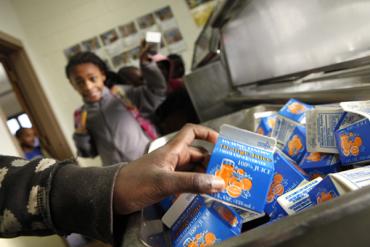Educators are united against President Trump’s proposal to undercut the Supplemental Nutrition Assistance Program, which would take away food assistance from millions and deny access to free school lunches to half a million kids.
Through the AFT’s Fund Our Future campaign, along with allies like the Food Research and Action Center (FRAC), we are fighting these proposed changes and holding up the opposite vision: a nation of children who are well-nourished and ready to learn.
AFT members have long supported greater access to good food for students. Our food service professionals promote, make and serve healthy meals. Many of our members keep a drawer or cabinet stashed with food for students who come to school hungry.
Without nutritious food, kids face a higher risk for absenteeism, behavior problems, mental illnesses and flagging academics. And with nearly half the nation’s students living in poverty and 1 in 5 not knowing where their next meal is coming from, school meals play a vital role. Some children get their only food at school.
Congress can strengthen the law the next time it reauthorizes child nutrition programs. According to the U.S. Department of Agriculture, school cafeterias served nearly 5 billion lunches in 100,000 schools in 2018, with nearly three-quarters of them free or at reduced prices. Of more than 2.4 billion school breakfasts served annually, 80 percent are free.
For the next update of the law, the AFT advises Congress to keep nutrition standards strong while further investing in school meals and SNAP for children, working families, seniors and individuals with disabilities. Fully investing in public education by adhering to the principles of Fund Our Future includes fully funding all child nutrition programs on the federal, state and local levels.
In the meantime, our union will fight the Trump proposal by responding to the USDA’s call for comments on the proposed regulations by the Sept. 23 due date. You can comment by going to the FRAC portal.
Here is where our union stands:
Expand funding
Because of rising food costs, USDA researchers say school meal programs are challenged to provide healthier and more appealing food. Our members urge Congress to provide significant new funding to raise the per-meal reimbursement rate and eliminate the “reduced-price” subsidy by expanding eligibility—in other words, letting students qualify for free meals.
End meal shaming
Congress must address school meal debt and ensure that children who participate in meal programs are not shamed for doing so. Many districts have “alternate meal” or “unpaid balance” policies for students who have surpassed some small threshold—such as a negative balance of $12. Children may be offered an alternate meal, given a sticker to wear, or asked to return a complete meal that’s already been set on their tray. Some school boards have hired debt collectors to chase families for small sums, or have even threatened to put a child in foster care for an unpaid balance.
AFT members report that these policies contribute to hunger, stigma and struggle. Kids can’t focus on learning if they are hungry or carrying shame.
“Meal shaming children is a cruel response to a budget problem,” says AFT Executive Vice President Evelyn DeJesus. “Children can’t help it if their parents can’t afford to pay, so we shouldn’t punish them for something they have no control over.”
In New York and Rhode Island, our local affiliates have helped pay off student debts, but this is only a temporary fix to a pervasive problem. “Charity cannot be the answer to deficiencies in public policy,” DeJesus says. “We must do better.”
Invest in 21st-century cafeterias
School meal programs quickly made innovations to meet the federal nutrition standards set in 2010. But schools need help to sustain that success. With the next overhaul of the law, Congress has a chance to turn attention from nutrition to infrastructure. In short, we need 21st-century school cafeterias:
- Congress must plan for and fund new kitchen equipment. USDA-administered equipment grants have helped thousands of schools buy kitchen gear, but these grants only scratch the surface.
- Congress should direct the USDA to link its rules for staff training to groundbreaking research. Making sure that school food service workers have the time and training to put this research to work will help schools sell healthier, tastier foods that kids want to eat.
- Congress should expand farm-to-school funding to better match demand.
Expand school breakfast
Study upon study underscores the importance of breakfast, which helps kids learn. Unfortunately, only about half the children who take part in the lunch program also participate in a school breakfast program.
The federal government should encourage schools to collaborate with everyone involved to figure out what will maximize participation in school breakfast. From bus drivers to custodians to food service workers, teachers and paraprofessionals, all staff should be included in expanding breakfast programs.
Give kids time to eat
Students now have access to healthier and fresher food, but far too many don’t have enough time to eat.
The American Academy of Pediatrics recommends that students get at least 20 minutes for lunch. The AFT calls for students to have at least 25 minutes of seated time. That means 25 minutes to actually sit down and eat—not time walking to the cafeteria or waiting in line.
The sad reality is that most kids get about 15 minutes to eat. That’s bad scheduling. Congress can instruct the USDA and the Centers for Disease Control and Prevention to provide districts guidance on thoughtful scheduling so that kids have enough time for meals.
Expand summer meals
Only 15 percent of children who get discounted school meals have access to summer meals. Congress should make it easier for children to eat during the summer by reducing paperwork; allowing communities with 40 percent of qualifying children to offer summer meals; and letting sites serving summer meals offer a third meal to kids in care for the whole workday. Finally, families with children who qualify should be able to get a summer debit card to buy food at retail stores when school is closed.
[Annette Licitra from staff reports]


